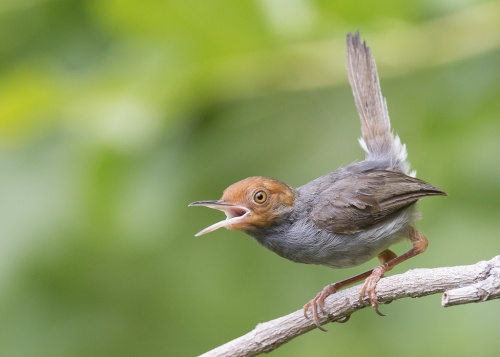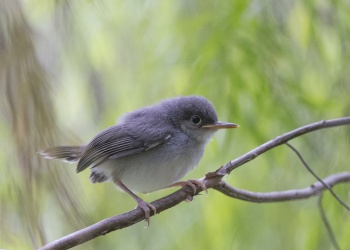(updated Clements reference) |
|||
| (8 intermediate revisions by 6 users not shown) | |||
| Line 1: | Line 1: | ||
| − | [[Image:36436058800 617f800ab3 b.jpg|thumb|500px|right| | + | [[Image:36436058800 617f800ab3 b.jpg|thumb|500px|right|Male<br />Photo by {{user|SeeToh|SeeToh}}<br />Garden by the Bay, [[Singapore]], August 2017]] |
;[[:Category:Orthotomus|Orthotomus]] ruficeps | ;[[:Category:Orthotomus|Orthotomus]] ruficeps | ||
==Identification== | ==Identification== | ||
| − | 12cm. <br /> | + | [[Image:AshyTailorbirdCS.jpg|thumb|350px|right| Photo by {{user|creaturesnapper|creaturesnapper}}<br /> [[Singapore]], September, 2017]] |
| + | 12cm (4¾ in). <br /> | ||
'''Male''': | '''Male''': | ||
*Dark ashy-grey | *Dark ashy-grey | ||
| Line 15: | Line 16: | ||
==Taxonomy== | ==Taxonomy== | ||
[[Olive-backed Tailorbird]] was considered conspecific with this species, but the split is widely accepted now. | [[Olive-backed Tailorbird]] was considered conspecific with this species, but the split is widely accepted now. | ||
| − | + | ||
====Subspecies==== | ====Subspecies==== | ||
| + | [[Image:36637435282 0f70ac1f80 b.jpg|thumb|350px|right|Juvenile<br />Photo by {{user|SeeToh|SeeToh}}<br />Chinese Garden, [[Singapore]], August 2017]] | ||
Clements recognises 8 subspecies<sup>[[#References|[1]]]</sup>: | Clements recognises 8 subspecies<sup>[[#References|[1]]]</sup>: | ||
*''O. r. cineraceus'': | *''O. r. cineraceus'': | ||
| Line 34: | Line 36: | ||
*''O. r. cagayanensis'': | *''O. r. cagayanensis'': | ||
:*Cagayan Sulu (south-western [[Philippines]]) | :*Cagayan Sulu (south-western [[Philippines]]) | ||
| − | |||
| − | |||
==Habitat== | ==Habitat== | ||
Mainly mangroves but also swampy forest and coastal scrub, forest edges, open country, lowland plantations, wooded gardens and secondary jungle. | Mainly mangroves but also swampy forest and coastal scrub, forest edges, open country, lowland plantations, wooded gardens and secondary jungle. | ||
| Line 44: | Line 44: | ||
The females sew a pouch from a large living leaf for their nest; the leaf is curled together by twisting spider web strands around it, the edges are joined together by making tiny holes on the edges of leaf with their pointed bills and finally through the holes, they lace through fibres from bark or cottony seed fibres. 2-6 pale blue eggs are laid and both parents incubate and raise the young. Chicks fledge in about 2 weeks. <sup>[[#References|[1]]]</sup> | The females sew a pouch from a large living leaf for their nest; the leaf is curled together by twisting spider web strands around it, the edges are joined together by making tiny holes on the edges of leaf with their pointed bills and finally through the holes, they lace through fibres from bark or cottony seed fibres. 2-6 pale blue eggs are laid and both parents incubate and raise the young. Chicks fledge in about 2 weeks. <sup>[[#References|[1]]]</sup> | ||
====Vocalisation==== | ====Vocalisation==== | ||
| − | + | {{ Audio|Memo (1).mp3 }} | |
| − | + | ||
Recording by {{user|wavethree|wavethree}}<br />Pulau Ubin, [[Singapore]] | Recording by {{user|wavethree|wavethree}}<br />Pulau Ubin, [[Singapore]] | ||
==References== | ==References== | ||
| − | #{{Ref- | + | #{{Ref-Clements6thOct24}}#Avibase |
| − | # | + | #BirdForum Member observations |
| − | + | ||
==External Links== | ==External Links== | ||
{{GSearch|Orthotomus+ruficeps}} | {{GSearch|Orthotomus+ruficeps}} | ||
[[Category:Birds]] [[Category:Orthotomus]] | [[Category:Birds]] [[Category:Orthotomus]] | ||
| + | {{GS-checked}} | ||
| + | <br /> | ||
| + | <br /> | ||
Latest revision as of 15:18, 17 May 2025
- Orthotomus ruficeps
Identification
12cm (4¾ in).
Male:
- Dark ashy-grey
- Whitish abdomen
- Rufous face, crown and throat
Female:
- Paler and duller than the male
- Pale chest and white belly
Juvenile: Paler with whitish throat
Distribution
Southeast Asia (endemic): found in Indochina, Myanmar, Thailand, Malaysia, Malay Peninsula, Brunei, Singapore, Philippines, Island of Borneo, Indonesia, Greater Sundas, Sumatra, Java, Lesser Sundas, Bali
Taxonomy
Olive-backed Tailorbird was considered conspecific with this species, but the split is widely accepted now.
Subspecies
Clements recognises 8 subspecies[1]:
- O. r. cineraceus:
- O. r. baeus:
- Nias and Pagai islands (off western Sumatra)
- O. r. concinnus:
- Siberut and Sipoura islands (off western Sumatra)
- O. r. ruficeps:
- Coastal mangroves of Java
- O. r. palliolatus:
- Kangean and Karimunjawa islands (Java Sea)
- O. r. baweanus:
- Bawean Island (Java Sea)
- O. r. borneoensis:
- O. r. cagayanensis:
- Cagayan Sulu (south-western Philippines)
Habitat
Mainly mangroves but also swampy forest and coastal scrub, forest edges, open country, lowland plantations, wooded gardens and secondary jungle.
Behaviour
Diet
They are often seen feeding on small insects in pairs or small family group.
Breeding
The females sew a pouch from a large living leaf for their nest; the leaf is curled together by twisting spider web strands around it, the edges are joined together by making tiny holes on the edges of leaf with their pointed bills and finally through the holes, they lace through fibres from bark or cottony seed fibres. 2-6 pale blue eggs are laid and both parents incubate and raise the young. Chicks fledge in about 2 weeks. [1]
Vocalisation
Recording by wavethree
Pulau Ubin, Singapore
References
- Clements, J. F., P. C. Rasmussen, T. S. Schulenberg, M. J. Iliff, T. A. Fredericks, J. A. Gerbracht, D. Lepage, A. Spencer, S. M. Billerman, B. L. Sullivan, M. Smith, and C. L. Wood. 2024. The eBird/Clements checklist of Birds of the World: v2024. Downloaded from https://www.birds.cornell.edu/clementschecklist/download/
- Avibase
- BirdForum Member observations
External Links
GSearch checked for 2020 platform.






